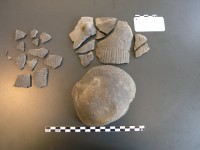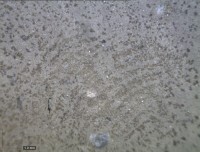It’s time to add another bullet point of to the list of exceptional artifacts discovered by the archaeological excavation in advance of the construction of the Fehmarn Belt Link tunnel on the island of Lolland, Denmark. There was the flint dagger with intact bark handle in October 2014, the 5,000-year-old gillnets and human footprints a month later, the flint axe with the intact wood handle 10 days after that and just last month they unearthed a Stone Age wood and bone eel fishing spear. Now Museum Lolland-Falster archaeologists have discovered a ceramic vessel bearing the fingerprint of the potter that made it 5,500 years ago.
 Discovered just east of the harbour town of Rødbyhavn on the same site where the intact flint axe was found, the vessel is an important in and of itself. It’s a funnel beaker, a pot with a flat base and a funnel-shaped neck that was so ubiquitous among the earliest farmers in Denmark that the period in which they were in use, the Funnel Beaker Culture (4,000 – 2,800 B.C.), was named after them. The funnel beakers from the early part of the period are simply decorated, but as potters gained experience in the technology, ornamentation got more elaborate. The beaker found on Lolland is from the late Funnel Beaker period and is decorated with an extensive pattern of small wedged dashes. A variety of tools were used to create the decorations, sometimes even fingers, but this is the first time a fingerprint has been found on a funnel beaker.
Discovered just east of the harbour town of Rødbyhavn on the same site where the intact flint axe was found, the vessel is an important in and of itself. It’s a funnel beaker, a pot with a flat base and a funnel-shaped neck that was so ubiquitous among the earliest farmers in Denmark that the period in which they were in use, the Funnel Beaker Culture (4,000 – 2,800 B.C.), was named after them. The funnel beakers from the early part of the period are simply decorated, but as potters gained experience in the technology, ornamentation got more elaborate. The beaker found on Lolland is from the late Funnel Beaker period and is decorated with an extensive pattern of small wedged dashes. A variety of tools were used to create the decorations, sometimes even fingers, but this is the first time a fingerprint has been found on a funnel beaker.
The beaker was found in large pieces, one of three funnel beakers unearthed at the site which were probably deliberately left as votive offerings. The axe was embedded in the seashore in a vertical position — not a likely posture had it just been discarded without a care — along with dozens of other artifacts from wooden candlesticks to spears and hundreds of animal bones. The vessels were likely deposited whole with food or drink inside. Over time the contents were lost and the ceramic broken.
 After they were excavated, the beaker pieces were sent to the National Museum of Denmark in Copenhagen for conservation. It was there upon close study that experts spotted the precious fingerprint.
After they were excavated, the beaker pieces were sent to the National Museum of Denmark in Copenhagen for conservation. It was there upon close study that experts spotted the precious fingerprint.
“The fragile fingerprint, left unintentionally, is an anonymous, yet very personal signature, which somehow brings us a bit closer to the prehistoric people and their actions,” [Museum Lolland-Falster archaeologist Line Marie] Olesen said.
Last year the same archaeological survey unearthed 5,000-year-old footprints left by people who attempted to save parts of their fishing system before it was flooded and covered in sand.
“An unknown persons gallery is gradually developing before our eyes, of the people who lived by Lolland’s southern coast at the time when agriculture was introduced some 6,000 years ago,” Anne-Lotte Sjørup Mathiesen of the Museum Lolland-Falster, said in a statement.
The beaker and fingerprint are still being studied at the National Museum. The vessel is expected to return to the Museum Lolland-Falster in December after which it will be put on display next to its brethren artifacts from the Rødbyhavn excavation.
Very nice, now the authorities will be able to apprehend the person responsible for the damage of the artifact.. 😮
The decoration appears to be cordage, wrapped around a slim stick or shell. Here in New England, we call this decoration “cord-wrapped stick” decoration, though the foundation is usually way to small to be a stick. I suspect they’re wrapping the cordage around bone or wood or shell
oops: toooo small, not ‘to small!”
Laurie, interesting observation. It seems plausible. The indentations look a little too parallel to me both as a spinner and a former potter to be cordage, but clay does draw up as it dries and is fired. The observation I wanted to make, though, is that these decorations may well have served a practical function: making it easier to hold onto a filled vessal without it slipping.
Seeing the finger print is awesome. I love seeing evidence of the maker on hand-made things.
“…and we’re gonna send your fingerprints off to Washington…and somewhere in Washington, a study in black and white, is a set of my fingerprints…” Alice’s Restaurant – Arlo Guthrie
Just thought it was funny…
I have been doing a research on fingerprints recently, Chinese were using footprints frequently 6000 years ago, how can all be just a coincidence I m sure they somehow knew about the unique characteristic of fingerprints but how ?